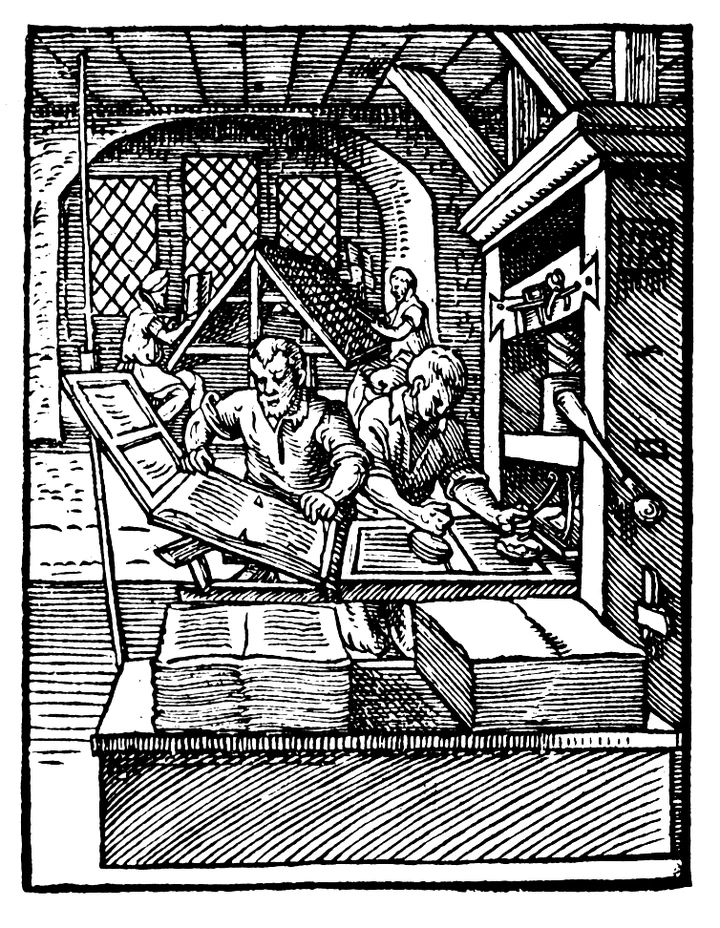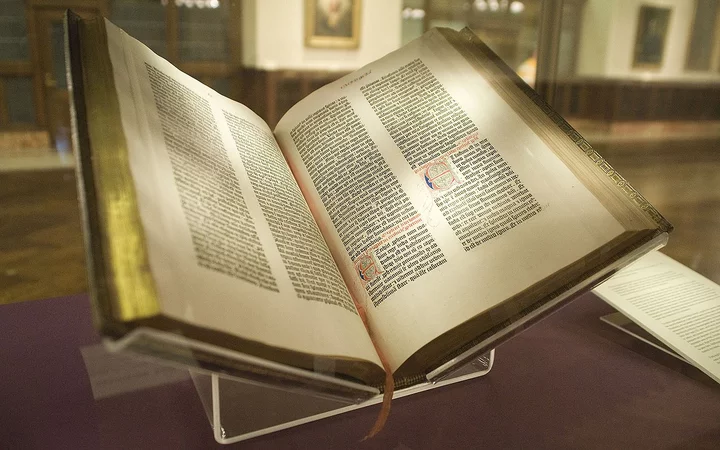When Johannes Gutenberg devised a complete system for mechanically printing books in the mid-1400s, he ushered in the Humanitarian Revolution, which embraces the Renaissance and every type of knowledge thereafter. The Catholic church, which — mostly — supported his endeavors (presumably liking the idea of there just being one version of the Latin “Vulgate” Bible, rather than versions that differed slightly from one another, scribal copying not being perfect), might not have been so sympathetic if they could have seen a few decades into the future.
Until Gutenberg, virtually the sole repository of learning in Europe was the Church, and the Bible was by far the most copied book — of course! The copyists were monks working in the scriptora (writing rooms) of monasteries, whose reward for spending years and years hunched over their tables, trying to stay warm month after month, year after year, would have been arthritic fingers and poor eyesight*. (In this life, at least: no doubt they had higher expectations for the life to come.) After Gutenberg, everything changed: books became more available, they were much cheaper than hand-copied volumes, and reading was democratized: more books meant more readers which meant more books…
* Convex spectacles, invented around 1230, would have added years to monks suffering from presbyopia.
The numbers are staggering. Pre-Gutenberg, there were perhaps no more than 30,000 books in all of Europe. By 1500, just 45 years after publication of his beautiful, 1,288-page, two-volume, leather-bound Bible, some 250 print shops in virtually every European country had printed at least 15 million books, all using Gutenberg’s system. (The first press to operate in the Americas was set up in 1539 in Mexico City, while the first in British North America was in Boston, in 1649.)
1568 woodcut illustration of a print shop, with an output of about 240 impressions per hour. We have no documentation of exactly what Gutenberg’s print shop looked like. (Public domain)
I wrote earlier that Gutenberg devised a system. His particular genius lay in combining inventions from previous ages, such as:
- The ink he used — a combination of lamp-black (soot), linseed oil and egg white, was already being used by artists of his time.
- His press was based upon wine presses (he was working in Mainz, in the heart of the Rhone wine country), except he had to figure out how to avoid the turning action of presses used in wineries.
- Having been trained as a goldsmith, it’s likely he already knew the required consistency of metal type, a mixture of lead and tin, with a little antimony (from antimony sulfide ore) mixed in to prevent cracking as it cooled.
- Movable metal type had already been figured out by Korean printers over a century earlier. We have copies of the Jikji (a treatise on Soto Buddhism) dating from 1377. Historians are divided on whether Gutenberg was aware of the Korean techniques.
- Historians do, however, credit Gutenberg with the invention of the hand mold, by which single letters could be cast repeatedly by pouring molten metal into a template containing a hand-carved letter, at a rate of perhaps one letter per minute.
By NYC Wanderer (Kevin Eng) - originally posted to Flickr as Gutenberg Bible, CC BY-SA 2.0, via Wikimedia
It’s hard to overstate just what mechanical printing meant for the world of science, of literature and of the humanities. Once books had been reduced to manageable sizes and prices (thanks to an Italian printer by the name of Aldus Manutius), you could curl up with a book and have essentially a direct mind-to-mind connection with the writer, whether you were reading a novel (think Cervantes’ Don Quixote), the latest discoveries in the heavens (think Galileo’s Starry Messenger), or philosophy (think Descartes’ Discourse on the Method).
Yet the man himself is a near mystery to historians. We’re uncertain when he was born (sometime between 1394 and 1406) although we know where (Mainz, Germany); we don’t know if he married or had children; and we don’t know what he looked like. Most information about his life derives from court records, in particular the case he lost as he was finishing the print run of about 180 Bibles. After being successfully sued for repayment of loans by his main patron, Johann Fust, he was forced to surrender his press and his remaining Bibles. Fust went on to form his own, successful, printing operation, availing himself of the knowledge brought by his foster son (and future son-in-law) Peter Schöffer, who up til then had been Gutenberg’s loyal assistant…while his teacher fades from history.
It
was an ignominious end to a genius whose name we associate today with
the beginnings of the modern world of knowledge. I plan on raising a
glass to Johannes Gensfleisch zur Laden zum Gutenberg just as soon as
I’ve finished spellchecking this column.


CLICK TO MANAGE